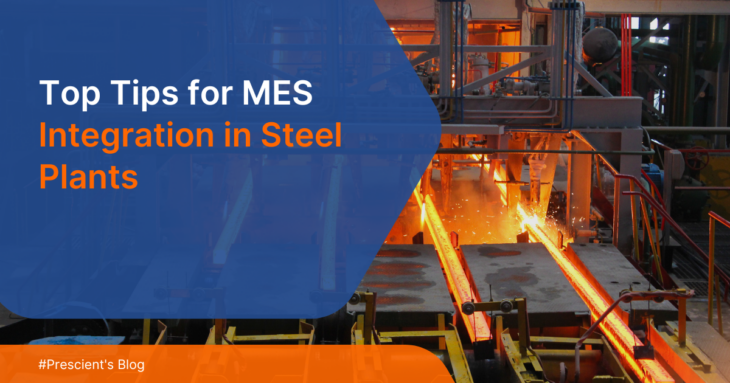Best Practices for Successful MES Integration in the Steel Industry
- Home
- Blog Details

- December 2 2024
- systemadmin
Steel production is one of the oldest industries in the world with well-established procedures and methodologies that have sustained for decades. In the modern day, the old ways are insufficient to deal with factors such as market volatility, costs, competition, etc. Implementing an MES system optimizes the functioning of steel plants by streamlining the processes and keeping up with the market. In this article, we take a closer look at the MES integration best practices steel industry. From setting clear goals to involving the right people and choosing the right solution, we’ll cover what it takes to make your MES implementation a success.
Table of Contents
ToggleTop Best Practices for Successful MES Integration

Let’s check out the best practices for successful integration in detail:
1. Identify the Need and Scope for MES
The first step in MES integration is understanding why you need it and what you want it to achieve. Start by asking what specific problems you are trying to solve. It can be real-time monitoring of the temperature of the cast billets, tight control of the composition of the steel, or gaining better visibility over the entire production. Clearly defining your goals will help you have a good picture. Next, consider the scope of the solution’s implementation. MES systems are often broad and cover everything from inventory management to real-time monitoring and client communication. Determine which areas of your plant will benefit the most to pick the right solution.
2. Discuss MES Features and Scope With All Stakeholders
Once you’ve identified the need for MES, it’s essential to involve all stakeholders, from the level of upper management to the operators, IT teams, and even the suppliers, in discussions about its features and scope. Explain how the MES will impact their work and highlight the benefits.
For example, automating reporting can reduce manual tasks for operators in the form of data gathering and report writing. Employees also won’t have to be around machinery all the time with data being available on their mobile devices. Transparency is key, especially for older workers who may fear technology changes. Address their concerns openly and show how MES will enhance, not replace, their roles.
3. Develop User Requirements for the System
Part of MES integration best practices steel industry starts with understanding the specific needs of those who will use it daily. Not all features offered by a solution are necessarily useful in the plant. Therefore, developing user requirements, which involves gathering input from everyone involved, from operators on the floor to IT specialists, is necessary. What do they need the system to do? Floor operators might require easy access to real-time data on production metrics, while IT teams would prioritize seamless integration with standardized data with existing systems. By involving users in this process, you ensure the MES is tailored to the plant’s unique needs.
4. Prepare Gap Analysis With Existing System and Interfaces
A major part of implementing MES is conducting a gap analysis to identify where your current systems fall short. In a steel factory, for example, you might find gaps in real-time data collection where older machines don’t provide timely information on production metrics. Another gap could be a lack of integration between the SCADA system and business software.
Fixing these involves prioritizing solutions like adding sensors to older equipment or using middleware to bridge different systems. Gap analysis helps you focus on areas that need improvement so a smoother MES integration and overall efficiency can be achieved.
5. Choose the Right MES Solution and Vendor
Start by evaluating your specific needs. Most MES system features out there have functionalities you require, like real-time monitoring, data analysis, or quality control. But what you need to consider is how well the system integrates with your existing equipment and software. Can the vendor handle the challenges unique to your plant and production methods, or can they adapt their system as needed?
Equally important is choosing a vendor with a strong track record in the steel industry. Look for a partner who understands your challenges and offers ongoing support. Don’t hesitate to ask for case studies or references to ensure their solution aligns with your goals.
6. Implement MES System incrementally
It’s ideal to take an incremental approach. Start with a pilot phase in a specific area of your plant, like with temperature sensors at the rolling mill or casting line or the energy meters across machines. This allows you to test the system, address any issues, and make adjustments before scaling up.
By rolling out the MES gradually, you can better manage disruptions, gather feedback from users, and ensure the system meets your expectations. Each successful step builds confidence among your team and helps refine the process, making the full-scale implementation smoother.
7. Focus on Training and Support
Even the best MES system can’t deliver results if your team isn’t fully trained to use it effectively. Build comprehensive training programs in a phased manner that follows the gradual implementation. The training should cover not just the basics but also how the system can be optimized for daily operations.
8. Measure and Optimize Performance
Continuously measuring the MES’s performance is key to ensuring you’re getting the most out of your investment. Start by tracking key metrics like energy consumption, downtime, quality control, and time to customer. For instance, if your MES shows a drop in the speed of billets moving from the annealing process to finishing, investigate the cause and make necessary adjustments. Then move on to the next process that has become a bottleneck.
Closing Thoughts
Successful MES integration in the steel industry is a process that requires careful planning, collaboration, and steady but continuous improvement. By following MES integration best practices steel, you can unlock the full potential of your operations.
If you’re looking to get started with an MES system at your plant, then look no further than FactoryCONNECT. The MES system offers seamless integration with all your existing hardware benefits that can transform your plant today.
Contact us to learn more and request a demo.


